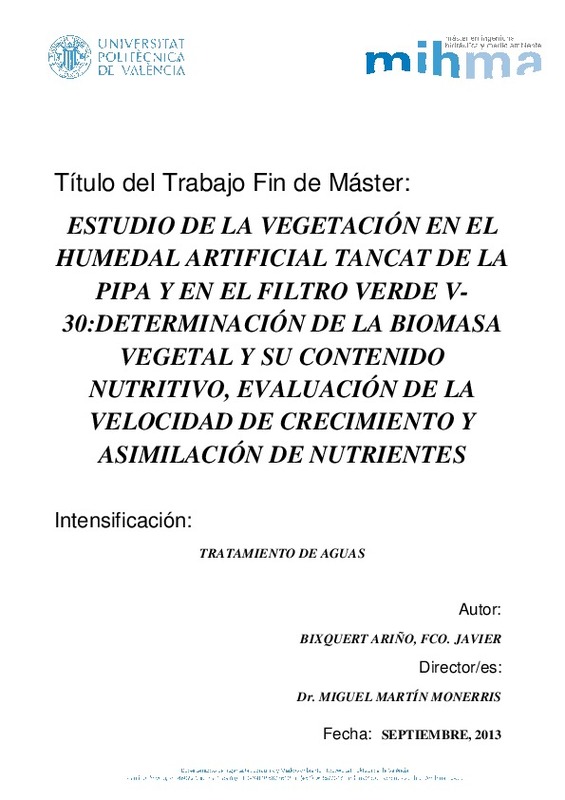

Estudio de la vegetación en el humedal artificial Tancat de la Pipa y en el filtro verde V-30: determinación de la biomasa vegetal y su contenido nutritivo, evaluación de la velocidad de crecimiento y asimilación de nutrientes
RiuNet: Repositorio Institucional de la Universidad Politécnica de Valencia
JavaScript is disabled for your browser. Some features of this site may not work without it.
Buscar en RiuNet
Listar
Mi cuenta
Estadísticas
Ayuda RiuNet
Admin. UPV
Estudio de la vegetación en el humedal artificial Tancat de la Pipa y en el filtro verde V-30: determinación de la biomasa vegetal y su contenido nutritivo, evaluación de la velocidad de crecimiento y asimilación de nutrientes
Mostrar el registro completo del ítem
Bixquert Ariño, FJ. (2013). Estudio de la vegetación en el humedal artificial Tancat de la Pipa y en el filtro verde V-30: determinación de la biomasa vegetal y su contenido nutritivo, evaluación de la velocidad de crecimiento y asimilación de nutrientes. http://hdl.handle.net/10251/35383
Por favor, use este identificador para citar o enlazar este ítem: http://hdl.handle.net/10251/35383
Ficheros en el ítem
Metadatos del ítem
| Título: | Estudio de la vegetación en el humedal artificial Tancat de la Pipa y en el filtro verde V-30: determinación de la biomasa vegetal y su contenido nutritivo, evaluación de la velocidad de crecimiento y asimilación de nutrientes | |||
| Autor: | Bixquert Ariño, Francisco Javier | |||
| Director(es): | ||||
| Entidad UPV: |
|
|||
| Fecha acto/lectura: |
|
|||
| Resumen: |
[ES] El presente Trabajo Final de Master de investigación tuvo como objetivo la determinación de
la biomasa vegetal, así como su contenido nutritivo, evaluación de la velocidad de
crecimiento y la asimilación de nutrientes ...[+]
[EN] This Master's Final research aimed at the determination of plant biomass and nutrient
content, as well as the assessment of growth rate and nutrient uptake by macrophytes plants
present in a subsurface flow system ...[+]
|
|||
| Palabras clave: |
|
|||
| Derechos de uso: | Reconocimiento - No comercial - Sin obra derivada (by-nc-nd) | |||
| Editorial: |
|
|||
| Titulación: |
|
|||
| Tipo: |
|






